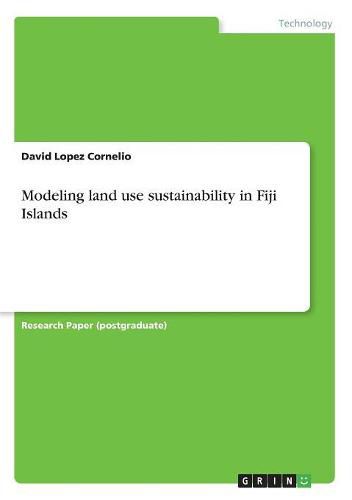Readings Newsletter
Become a Readings Member to make your shopping experience even easier.
Sign in or sign up for free!
You’re not far away from qualifying for FREE standard shipping within Australia
You’ve qualified for FREE standard shipping within Australia
The cart is loading…






This title is printed to order. This book may have been self-published. If so, we cannot guarantee the quality of the content. In the main most books will have gone through the editing process however some may not. We therefore suggest that you be aware of this before ordering this book. If in doubt check either the author or publisher’s details as we are unable to accept any returns unless they are faulty. Please contact us if you have any questions.
Research Paper (postgraduate) from the year 2017 in the subject Environmental Sciences, Fiji National University (College of Agriculture, Fisheries and Forestry Fiji National University), language: English, abstract: Fiji Islands are among the most dynamic economies in the South Pacific, with rapid changes on infrastructure and industrial developments, tourism and commercial agriculture; even though they often come alongside environmental impacts on endemic biota and ecosystems that are not well understood, not much is invested on research to plan a sustainable use of land. Parallel unsolved concerns are land tenure issues in which ancestral community ownership coexists with modern markets; tensions over land leases between ethnical groups and high population growth trigger land use intensification, and rise of emigrations, of landlessness, of unemployment and finally of poverty. Therefore, it is of a national interest to asses these trends for long term sustainable land use planning; even nearly 3500 years ago a record of regulations aimed to achieve sustainability and equality: 3 …for six years you may plant crops inyour fields, prune your vineyards, and gather what they produce. 4 But during the seventh year, you must let the land rest. 8 Count seven of these years seven times for a total of 49 years… during that time there will be seven -years of rest 9 and proclaim liberty to everyone living in the land… everyone is to return to their own property (Leviticus 25). In this document, the first chapter is a synopsis of land use in the rural areas of Fiji islands, its evolution, types, problems and alternatives, the second chapter is a review of some common free gis packages available in the internet useful for forestry and land use evaluations, their number and degrees of sophistication are ever growing; the last two chapters are applications, first on detecting the severity of land use intensity in relation to other socioeconomic parameters, and second on
$9.00 standard shipping within Australia
FREE standard shipping within Australia for orders over $100.00
Express & International shipping calculated at checkout
This title is printed to order. This book may have been self-published. If so, we cannot guarantee the quality of the content. In the main most books will have gone through the editing process however some may not. We therefore suggest that you be aware of this before ordering this book. If in doubt check either the author or publisher’s details as we are unable to accept any returns unless they are faulty. Please contact us if you have any questions.
Research Paper (postgraduate) from the year 2017 in the subject Environmental Sciences, Fiji National University (College of Agriculture, Fisheries and Forestry Fiji National University), language: English, abstract: Fiji Islands are among the most dynamic economies in the South Pacific, with rapid changes on infrastructure and industrial developments, tourism and commercial agriculture; even though they often come alongside environmental impacts on endemic biota and ecosystems that are not well understood, not much is invested on research to plan a sustainable use of land. Parallel unsolved concerns are land tenure issues in which ancestral community ownership coexists with modern markets; tensions over land leases between ethnical groups and high population growth trigger land use intensification, and rise of emigrations, of landlessness, of unemployment and finally of poverty. Therefore, it is of a national interest to asses these trends for long term sustainable land use planning; even nearly 3500 years ago a record of regulations aimed to achieve sustainability and equality: 3 …for six years you may plant crops inyour fields, prune your vineyards, and gather what they produce. 4 But during the seventh year, you must let the land rest. 8 Count seven of these years seven times for a total of 49 years… during that time there will be seven -years of rest 9 and proclaim liberty to everyone living in the land… everyone is to return to their own property (Leviticus 25). In this document, the first chapter is a synopsis of land use in the rural areas of Fiji islands, its evolution, types, problems and alternatives, the second chapter is a review of some common free gis packages available in the internet useful for forestry and land use evaluations, their number and degrees of sophistication are ever growing; the last two chapters are applications, first on detecting the severity of land use intensity in relation to other socioeconomic parameters, and second on